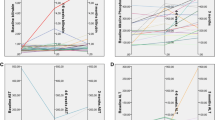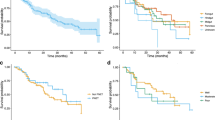Abstract
Purpose
Radioembolization of liver metastases of neuroendocrine neoplasms (NEN) has shown promising results; however, the current literature is of limited quality. A large international, multicentre retrospective study was designed to address several shortcomings of the current literature.
Materials
244 NEN patients with different NEN grades were included.
Methods
Primary outcome parameters were radiologic response 3 and 6 months after treatment according to RECIST 1.1 and mRECIST. Secondary outcome parameters included clinical response, clinical and biochemical toxicities.
Results
Radioembolization resulted in CR in 2%, PR in 14%, SD in 75% and PD 9% according to RECIST 1.1 and in CR in 8%, PR in 35%, SD in 48% and PD in 9% according to mRECIST. Objective response rates improved over time in 20% and 26% according to RECIST 1.1. and mRECIST, respectively. Most common new grade 3–4 biochemical toxicity was lymphocytopenia (6.7%). No unexpected clinical toxicities occurred. Radioembolization-specific complications occurred in < 4%. In symptomatic patients, improvement and resolution of symptoms occurred in 44% and 34%, respectively. Median overall survival from first radioembolization was 3.7, 2.7 and 0.7 years for G1, G2 and G3, respectively. Objective response is independent of NEN grade or primary tumour origin. Significant prognostic factors for survival were NEN grade/Ki67 index, ≥ 75% intrahepatic tumour load, the presence of extrahepatic disease and disease control rate according to RECIST 1.1.
Conclusion
Safety and efficacy of radioembolization in NEN patients was confirmed with a high disease control rate of 91% in progressive patients and alleviation of NEN-related symptoms in 79% of symptomatic patients.
Level of evidence
4.




Similar content being viewed by others
References
Heetfeld M, Chougnet CN, Olsen IH, et al. Characteristics and treatment of patients with G3 gastroenteropancreatic neuroendocrine neoplasms. Endocr Relat Cancer. 2015;22(4):657–64. https://doi.org/10.1530/ERC-15-0119.
Rindi G, Petrone G, Inzani F. The 2010 WHO classification of digestive neuroendocrine neoplasms: a critical appraisal four years after its introduction. Endcr Pathol. 2014;25(2):186–92. https://doi.org/10.1007/s12022-014-9313-z.
Pavel M, Baudin E, Couvelard A, et al. ENETS Consensus Guidelines for the management of patients with liver and other distant metastases from neuroendocrine neoplasms of foregut, midgut, hindgut, and unknown primary. Neuroendocrinology. 2012;95(2):157–76. https://doi.org/10.1159/000335597.
Lawrence B, Gustafsson BI, Chan A, et al. The epidemiology of gastroenteropancreatic neuroendocrine tumors. Endocrinol Metab Clin North Am. 2011;40(1):1–18. https://doi.org/10.1016/j.ecl.2010.12.005.
Frilling A, Li J, Malamutmann E, Schmid KW, et al. Treatment of liver metastases from neuroendocrine tumours in relation to the extent of hepatic disease. Br J Surg. 2009;96(2):175–84. https://doi.org/10.1002/bjs.6468.
Strosberg JR, El-Haddad G, Wolin E, et al. Phase 3 trial of 177Lu-dotatate for midgut neuroendocrine tumors. N Eng J Med. 2017;376(2):125–35. https://doi.org/10.1056/NEJMoa1607427.
Yao JC, Fazio N, Singh S, et al. Everolimus for the treatment of advanced, non-functional neuroendocrine tumours of the lung or gastrointestinal tract (RADIANT-4): a randomised, placebo-controlled, phase 3 study. Lancet. 2016;387:968–77. https://doi.org/10.1016/S0140-6736(15)00817-X.
Caplin ME, Pavel M, Ćwikła JB, et al. Lanreotide in metastatic enteropancreatic neuroendocrine tumors. N Eng J Med. 2014;371(3):224–33. https://doi.org/10.1056/NEJMoa1316158.
Raymond E, Dahan L, Raoul JL, et al. Sunitinib malate for the treatment of pancreatic neuroendocrine tumors. N Eng J Med. 2011;364(6):501–13. https://doi.org/10.1056/NEJMoa1003825.
Frilling A, Modlin IM, Kidd M, et al. Recommendations for management of patients with neuroendocrine liver metastases. Lancet Oncol. 2014;15(1):e8–21. https://doi.org/10.1016/S1470-2045(13)70362-0.
Devcic Z, Rosenberg J, Braat AJAT, et al. The efficacy of hepatic 90Y resin radioembolization for metastatic neuroendocrine tumors: a meta-analysis. J Nucl Med. 2014;55(9):1404–10. https://doi.org/10.2967/jnumed.113.135855.
Kennedy AS, Bester L, Salem R, et al. Role of hepatic intra-arterial therapies in metastatic neuroendocrine tumours (NET): guidelines from the NET-Liver-Metastases Consensus Conference. HBP (Oxford). 2015;17(1):29–37. https://doi.org/10.1111/hpb.12326.
Lam MGEHLJ, Iagaru AH, Goris ML, Sze DY. Safety of repeated yttrium-90 radioembolization. Cardiovasc Intervent Radiol. 2013;36(5):1320–8. https://doi.org/10.1007/s00270-013-0547-9.
Salem R, Lewandowski RJ, Gates VL, et al. Research reporting standards for radioembolization of hepatic malignancies. J Vasc Interv Radiol. 2011;22(3):265–78. https://doi.org/10.1016/j.jvir.2010.10.029.
Response Evaluation Criteria In Solid Tumors. www.recist.com. Accessed March 2016.
Lencioni R, Llovet JM. Modified RECIST (mRECIST) assessment for hepatocellular carcinoma. Semin Liver Dis. 2010;30(1):52–60.
USA NCI. Common terminology criteria in adverse events, version 4.03 (CTCAE v4.03). NIH. 2010. http://www.hrc.govt.nz/sites/default/files/CTCAE%20manual%20-%20DMCC.pdf. Accessed March 2016.
Ludwig JM, Ambinder EM, Ghodadra 3, et al. Lung shunt fraction prior to yttrium-90 radioembolization predicts survival in patients with neuroendocrine liver metastases: single-center prospective analysis. Cardiovasc Intervent Radiol. 2016;39(7):1007–14. https://doi.org/10.1007/s00270-016-1323-4.
Sommer WH, Ceelen F, Garcia-Albeniz X, et al. Defining predictors for long progression-free survival after radioembolisation of hepatic metastases of neuroendocrine origin. Eur Radiol. 2013;23(11):3094–103. https://doi.org/10.1007/s00330-013-2925-8.
Peker A, Çiçek O, Soydal Ç, et al. Radioembolization with yttrium-90 resin microspheres for neuroendocrine tumor liver metastases. Diagn Interv Radiol. 2015;21(1):54–9. https://doi.org/10.5152/dir.2014.14036.
Singla S, LeVea CM, Pokuri VK, et al. Ki67 score as a potential predictor in the selection of liver-directed therapies for metastatic neuroendocrine tumors: a single institutional experience. J Gastrointest Oncol. 2016;7(3):441–8. https://doi.org/10.21037/jgo.2016.02.02.
Cao CQ, Yan TD, Bester L, et al. Radioembolization with yttrium microspheres for neuroendocrine tumour liver metastases. Br J Surg. 2010;97(4):537–43. https://doi.org/10.1002/bjs.6931.
Chen JX, Rose S, White SB, et al. Embolotherapy for neuroendocrine tumor liver metastases: prognostic factors for hepatic progression-free survival and overall survival. Cardiovasc Intervent Radiol. 2017;40(1):69–80. https://doi.org/10.1007/s00270-016-1478-z.
Barbier CE, Garske-Román U, Sandström M, et al. Selective internal radiation therapy in patients with progressive neuroendocrine liver metastases. Eur J Nucl Med Mol Imaging. 2016;43(8):1425–31. https://doi.org/10.1007/s00259-015-3264-6.
Kennedy AS, Dezarn WA, McNeillie P, et al. Radioembolization for unresectable neuroendocrine hepatic metastases using resin 90Y-microspheres: early results in 148 patients. Am J Clin Oncol. 2008;31(3):271–9. https://doi.org/10.1097/COC.0b013e31815e4557.
Saxena A, Chua TC, Bester L, et al. Factors predicting response and survival after yttrium-90 radioembolization of unresectable neuroendocrine tumor liver metastases: a critical appraisal of 48 cases. Ann Surg. 2010;251(5):910–6. https://doi.org/10.1097/SLA.0b013e3181d3d24a.
Ozao-Choy J, Friedman ML, Kim AS, et al. Radioembolization for treatment of liver metastases from neuroendocrine tumors: correlation with imaging and biomarkers. Pancreas. 2013;42(2):358–60. https://doi.org/10.1097/MPA.0b013e31825f4087.
Tomozawa Y, Jahangiri Y, Pathak P, Kolbeck KJ, Schenning RC, Kaufman JA, Farsad K. Long-term toxicity after transarterial radioembolization with yttrium-90 using resin microspheres for neuroendocrine tumor liver metastases. J Vasc Interv Radiol. 2018;29(6):858–65. https://doi.org/10.1016/j.jvir.2018.02.002.
Kennedy AS, McNeillie P, Dezarn WA, et al. Treatment parameters and outcome in 680 treatments of internal radiation with resin 90Y-microspheres for unresectable hepatic tumors. Int J Radiat Oncol Biol Phys. 2009;74(5):1494–500. https://doi.org/10.1016/j.ijrobp.2008.10.005.
Elschot M, Nijsen JF, Lam MGEH, et al. (99m)Tc-MAA overestimates the absorbed dose to the lungs in radioembolization: a quantitative evaluation in patients treated with 166Ho-microspheres. Eur J Nucl Med Mol Imaging. 2014;41(10):1965–75. https://doi.org/10.1007/s00259-014-2784-9.
Soulen MC, van Houten D, Teitelbaum UR, Damjanov N, Cengel KA, Metz DC. Safety and feasibility of integrating yttrium-90 radioembolization with capecitabine-temozolomide for grade 2 liver-dominant metastatic neuroendocrine tumors. Pancreas. 2018;47(8):980–4.
Braat AJAT, Kwekkeboom DJ, Kam BLR, et al. Additional hepatic 166Ho-radioembolization in patients with neuroendocrine tumours treated with 177Lu-DOTATATE; a single center, interventional, non-randomized, non-comparative, open label, phase II study (HEPAR PLUS trial). BMC Gastroenterol. 2018;18(1):84. https://doi.org/10.1186/s12876-018-0817-8.
Mikell JK, Mahvash A, Siman W, et al. Selective internal radiation therapy with yttrium-90 glass microspheres: biases and uncertainties in absorbed dose calculations between clinical dosimetry models. Int J Radiat Oncol Biol Phys. 2016;96(4):888–96. https://doi.org/10.1016/j.ijrobp.2016.07.021.
Garin E, Lenoir L, Edeline J, et al. Boosted selective internal radiation therapy with 90Y-loaded glass microspheres (B-SIRT) for hepatocellular carcinoma patients: a new personalized promising concept. Eur J Nucl Med Mol Imaging. 2013;40(7):1057–68. https://doi.org/10.1007/s00259-013-2395-x.
Smits MLJ, Elschot M, Sze DY, et al. Radioembolization dosimetry: the road ahead. Cardiovasc Intervent Radiol. 2015;38(2):261–9. https://doi.org/10.1007/s00270-014-1042-7.
Chansanti O, Jahangiri Y, Matsui Y, et al. tumor dose response in yttrium-90 resin microsphere embolization for neuroendocrine liver metastases: a tumor-specific analysis with dose estimation using SPECT-CT. J Vasc Interv Radiol. 2017;28(11):1528–35. https://doi.org/10.1016/j.jvir.2017.07.008.
Fidelman N, Kerlan RK Jr, Hawkins RA, et al. 90Y glass microspheres for the treatment of unresectable metastatic liver disease from chemotherapy-refractory gastrointestinal cancers: a pilot study. J Gastrointest Cancer. 2014;45(2):168–80. https://doi.org/10.1007/s12029-013-9566-7.
Turkmen C, Ucar A, Poyanli A, et al. Initial outcome after selective intraarterial radionuclide therapy with yttrium-90 microspheres as salvage therapy for unresectable metastatic liver disease. Cancer Biother Radiopharm. 2013;28(7):534–40. https://doi.org/10.1089/cbr.2012.1455.
Cramer B, Xing M, Kim HS. prospective longitudinal quality of life assessment in patients with neuroendocrine tumor liver metastases treated with 90Y radioembolization. Clin Nucl Med. 2016;41(12):e493–7. https://doi.org/10.1097/RLU.0000000000001383.
Funding
Travel expenses and accommodations of AJATB were partially covered by Sirtex Medical Europe, producer of SIR-spheres. Remaining travel expenses were granted by the Girard de Mielet van Coehoorn Foundation (Grant of the Board of Directors UMC Utrecht, the Netherlands). Both parties have no access to the data and have not been involved in data analysis or in the writing of the manuscript.
Author information
Authors and Affiliations
Corresponding author
Ethics declarations
Conflict of interest
C.M.D. has acted as a consultant for Sirtex, Bayer Healthcare and Ipsen. A.F. receives research funding from Ipsen, Novartis and Sirtex Medical. D.B.B is a consultant for BTG, receives research funding from Sirtex and has served on a speaker’s bureau for Boston Scientific. D.Y.S. has acted as consultant for BTG, Boston Scientific, Amgen, EmbolX and Viralytics. M.G.E.H.L. has acted as a consultant for BTG, Sirtex, Mirada and Bayer Healthcare. All other authors have no conflicts of interest to declare.
Electronic supplementary material
Below is the link to the electronic supplementary material.
Rights and permissions
About this article
Cite this article
Braat, A.J.A.T., Kappadath, S.C., Ahmadzadehfar, H. et al. Radioembolization with 90Y Resin Microspheres of Neuroendocrine Liver Metastases: International Multicenter Study on Efficacy and Toxicity. Cardiovasc Intervent Radiol 42, 413–425 (2019). https://doi.org/10.1007/s00270-018-2148-0
Received:
Accepted:
Published:
Issue Date:
DOI: https://doi.org/10.1007/s00270-018-2148-0




